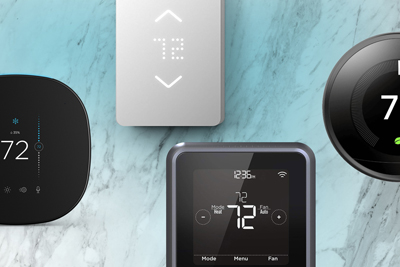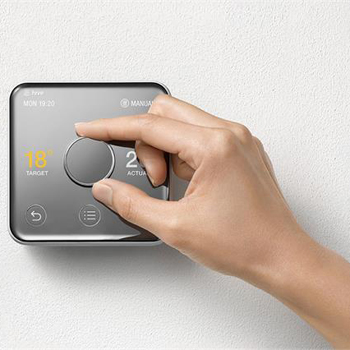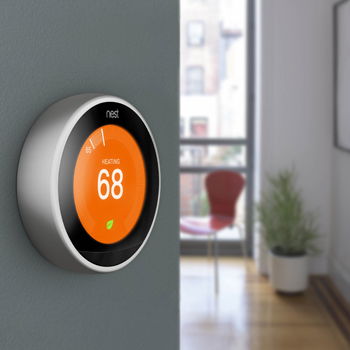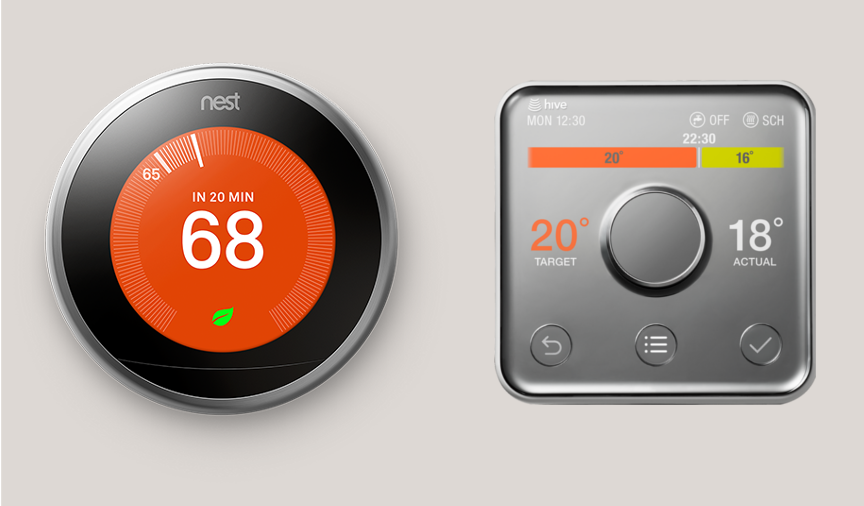Eco-friendly homes are available for everyone, and one of the key components of this is the smart thermostat. These clever little devices are able to control your hot water and central heating in a much more efficient way than conventional thermostats. There are a number of different smart thermostats out there, all with their own features that make them unique. Two of the biggest names in the game at the moment are Hive and Nest. So we thought it’d be a great idea to put the two together and decide which is best.
The Nest thermostat, which uses technology from Google, has been around for almost a decade now. Since 2011, the Nest thermostat has always been one of the best in the business. Hive have also been making smart thermostats for quite some time. However it wasn’t until they released the 2nd generation of the Hive smart thermostat that they became a serious contender to the Nest version.
Why Install a Smart Thermostat?

One of the key aspects of a smart thermostat is that it allows you to control the central heating and hot water within your home from anywhere in the world. This means that as long as you have an internet connection you can control your boiler. This extra control over your heating allows you to do other cool things such as heat individual rooms at different temperatures. This can go a long way to reducing the cost of your energy bills.
The other thing that makes smart thermostats smart, is the fact that they adapt to changes in temperature caused by local weather conditions. This will prevent your pipes from freezing on the colder days, while at the same time preventing your home from overheating when it’s hot outside.
When you have a clearer picture of how much energy you are using, it is much easier to control the way you use energy and therefore take control of your energy bills. This is the fundamental principle of the smart thermostat.
When it comes to performance, there is little difference between the Nest and Hive thermostats. For the key features, both are pretty much on par with each other. However there are a few differences that may go some way to sway your decision when it comes to purchasing.
Hive Vs Nest: Differences at a Glance
| Hive | Nest | |
| Price | £249 or £179 self-fitted | £249 or £199 self-fitted |
| Installation cost | £70 | £50 |
| Colour | Black | Grey |
| Size | 140mm x 48mm x 10mm | 117mm x 24mm |
| Mounting | Hub | Wall-mounted |
| Compatibility | Gas and LPG boilers with existing thermostat, electric boilers | Virtually all central heating systems |
| Connectivity | Internet 1.5Mbps, iOS or Android device | Wi-Fi internet, device running Android or iOS |
| Powered by | 4x AA batteries and mains plug | Built in, rechargeable lithium ion battery |
| Zone capability | 3 zones | Up to 20 zones and 3 locations |
| Power consumption | Less than 1kW per month | Less than 1 kW per month |
| Warranty | 1 year | 2 years |
The Hive Smart Thermostat

Hive features an intelligent wireless system that is designed to replace your existing thermostat. All you need is a broadband connection. It’s then a case of installing the Hive app and you’ll be able to control your central heating and hot water from remote locations.
If you know what you’re doing, you can save £70 on the cost of the Hive thermostat by installing it yourself. However the recommended advice for most people by British Gas themselves is to have one of their engineers install it for you.
You don’t have to be a British Gas customer to have Hive installed in your home. However, if you switch to British Gas then they can supply and fit your Hive hub for just £99. This offer is subject to change, so make sure British Gas are still able to do this if you are considering switching to them.
An advantage of being a British Gas customer is that they will allow you to spread the cost with their Hive Heating Plan. This means you can pay for your Hive hub over the course of 12 months.
With the latest (2nd generation) Hive, you can program 6 different settings and control 3 zones independently from each other. If you want to control more rooms, then you will need an additional thermostat.
Unlike the Nest thermostat, all heating settings are input manually with Hive. Nest is able to learn your heating routine and make things completely automatic. The main advantage of this is that you have more control over the flexibility of your heating. Hive is able to send you alerts when the temperature of your home changes, if you forgot to turn your heating off for example.
Another great thing about the Hive smart thermostat is the fact that you can configure Amazon Alexa or Google Assistant to turn your heating on and off for you, and send yourself alerts to turn your heating off when it isn’t required.
The Nest Smart Thermostat

The main selling point of the latest and greatest Nest thermostat is the fact that it features algorithms. This means that over the course of a couple of weeks, your Nest thermostat will learn your daily central heating and hot water routines, and then set the temperatures accordingly. With this smart technology your Nest thermostat will learn when you leave the house, when you return home and even whether you prefer a lie-in at the weekend.
This means that if you live within a household that has set routines, the Nest thermostat will be well-suited to your needs. Despite this, the routines that Nest learns can be over-ridden. You can manually adjust settings when you need to. The thermostat also has other built-in functions that will allow you to monitor your energy usage.
One of these features is a detector that can identify when someone is in the house, as well as which room they are in. The Nest thermostat will then set the heat accordingly, so that you can save money by not heating the rooms that you are not using.
Like Hive and most other smart thermostats, the Nest smart thermostat can be operated by an app on your mobile phone. Another great feature is that you can sync your Nest thermostat to your GPS so it knows when you’re on the way home.
The Nest smart thermostat also has a feature that can read the weather forecast and detect a change in outside temperature. This is called the True Radiant feature, and it helps to heat your home as the temperature changes outside – perfect for the unpredictable weather in the UK.
In terms of compatibility, the Nest smart thermostat has no problems. It’s compatible with almost every central heating system available in the UK, and that includes underfloor heating. With the Nest thermostat you can set different times and temperatures for up to 20 different rooms across 3 different locations.
Nest Vs Hive Smart Thermostat: Price
In terms of price, there’s not a lot of difference between Nest and Hive. Both are around the £249 mark if you wish to get it fitted. If you’re competent enough to fit your smart thermostat yourself, then you can buy the Hive without installation included for £179. Nest costs £199 if you wish to self-fit.
The only real difference is that you can get the Hive smart thermostat considerably cheaper if you sign up to British Gas for your gas and electricity. If you do this, then it costs just £99, and that includes fitting. And as an added bonus, British Gas will allow you to spread the cost over a year with no interest to pay.
Nest Vs Hive Smart Thermostat: Power
Both the Nest and Hive smart thermostats are powered by batteries. The main difference is that the Hive is powered by 4 AA batteries, which will need to be changed periodically. Even if you use rechargeable batteries, you will still have to remove the batteries to replace them every so often. Both the Hive thermostat itself and the Hive app will give you plenty of notice when the batteries need changing.
The Nest thermostat is a little more technologically-advanced. It features a built-in lithium ion battery that can be recharged time and time again. That said, you will still need to charge it every so often via a mini USB cable.
So which is best: Nest or Hive?
When it comes to key features of smart thermostats, the Nest and Hive options are very similar. They both offer the usual basic functions like any other smart thermostat. However if you want smart thermostat that is more of a gadget, then the Nest thermostat is a no brainer. The Nest is packed with technology such as its learning algorithm and motion detector.
Although it’s fun to have the latest technology, cost and convenience is also an important factor when choosing a smart thermostat. For example, the Nest thermostat may turn your heating on when you don’t actually want it to.
If you have a set routine that doesn’t change much, then the Nest smart thermostat will compliment your everyday life very well. However, if you wish to have more flexibility and control over your heating, then you will probably be better suited to the Hive.
Frequently Asked Questions
No, you don’t. Although if you switch to British Gas then you can take advantage of their promotion which means that they will supply and fit your Hive system for just £99.
Yes, you can. In fact this is one of the key features of a smart thermostat. The Hive smart thermostat will allow you to have up to 3 different zones, whereas the Nest will allow you to have up to 20 thermostats.
The Nest smart thermostat is designed to be automatic. It isn’t completely automated though, so you can override it at any time. For example if you wish to boost the heat or hot water functions.

One reply on “Hive Vs Nest : Which is Better?”
THANKS very useful information, can you tell me if Hive are going to go bust though as I heard theyre not going to be around muchlonger